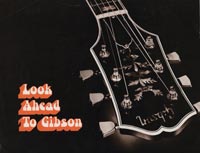
Gibson issued regular promotional material for it's products: catalogues every two years or so, dealer handouts, advertisements in guitar magazines, and Gibson's own magazines Gibson Gazette and Gibson Backstage Pass. Some publications were 'full-line' containing Gibson's entire product range. Others were segment, or even model-specific. Most of Gibson's guitars, basses and amplifiers are included amongst the pages of these catalogues, and many variations within a model can be tracked from catalogue to catalogue, both in the pictures, but also in the included specifications. The majority of these brochures state that materials and specifications could be changed without notice, so the information within, whilst generally accurate can not be regarded as absolute.
Gibson produced it's literature for the US guitar-buying market, but in the rest of the world, it was the responsibility of the overseas distributor, Selmer then Rosetti in the UK, Monzino in Italy etc. Gibson guitars often appeared in leaflets and brochures printed by these companies.
1958 Gibson electric guitar and amplifier catalogue. This was a time of innovation at Gibson and although the catalogue did not contain all of the new guitars of 1958, it did include two new-legendary designs, the ES-335TD and Flying V guitars - aswell as the EB2 bass.
1960 Gibson full line catalogue. The solid body and thinline ranges were expanding significantly at this time. New instruments for 1960 included the ES-330, ES-345 and ES-355, plus the early style Melody Maker, SG Special and EB-O bass.
1962 Gibson full line catalogue. This catalogue debuted the familiar 'batwing' SG series, including EB0 and EB3 basses, plus Artist series jazz instruments, the Johnny Smith and Barney Kessel.
The new Firebird guitar and Thunderbird bass were announced in mid-1963. Specification sheets for each model (four guitars and two basses) were produced by Gibson to accompany the instruments launch.
1964 'Brilliant' Gibson guitar and bass catalogue. 16 pages. Yet again, new (yet soon-to-be classic) guitars were included in the form of Firebird guitars, and Thunderbird basses.
Towards the end of the 1960s, Gibson was running into a number of financial, managerial and production issues; ultimately culminating in parent company CMI giving way to Norlin in December 1969. New models were thin on the ground at this time, although there was much fanfare for the new reissued Les Paul guitars.
Published by new owners Norlin, in early 1970. For this catalogue, they changed from the usual approach of offering full line catalogues and published a series of pamphlets each around 8-12 pages long containing just a small segment of the 1970 range. Naturally this reduced overall costs, as potential customers would only take the brochures featuring the instruments relevant to them, but it also allowed easy revision of certain segments as the instruments available changed. Titles included: solid bodies, thinlines, Les Pauls, basses, banjos, electric acoustics, carved top acoustics, mandolins, flattops, 12-string flattops and classic guitars. Note the new 'foliage' motif, used throughout the 1970s being used here for the first time.
The Gibson 'guitar of the month' showcase series of brochures published in 1972 provide a detailed look at some of Gibson's higher end models - each is a single sheet folded down to four panels.

The 1978 Gibson catalogue was the first full-line catalogue of the Norlin period. New models first included in the 1978 Gibson catalogue include the Gibson RD guitar and bass, the the ES-347TD and several Les Paul models: The Les Paul, LP Artisan, and LP 55/78
Summer 1981 saw the release of 10 Gibson 'pre-owners manuals' - actually mini folders with loose-leaf inserts, one for each model. Each manual represented one segment of the Gibson line. At this time, Rosetti took over distribution of the Gibson line in the UK, and produced their first Gibson guitar catalogue at the tail end of the year.
In '82 Gibson produced a number of single sheet flyers, typically with one or more folded panels with extra details. Some of these flyers were also placed as advertisements (minus the fold out panel) in Guitar Player and similar magazines. Only the front panels are shown here - click to see the full flyer.
$50
$500
$225
$50
$50
$225
€49
$75
€39
£32